15 ways to adjust the brightness of computer and laptop screens
You will have to change the screen brightness to match the surrounding light environment. If working in low light conditions, you will have to reduce the brightness of your computer or laptop screen to suit the darkness. around.
At the same time, reducing screen brightness will also help save laptop battery and extend usage time. Reducing screen brightness will also help reduce visual strain.
TipsMake.com will help you with many ways to reduce screen brightness on your desktop computer (PC) and increase laptop screen brightness.
Additionally, if you are using a Windows 7 computer, and you want to adjust the computer screen brightness to protect your eyes as well as extend laptop battery life, you can refer to the steps here.
Adjust screen brightness for desktop computers
1. Reduce PC screen brightness using Settings
On a desktop computer (PC), you will not have function keys like on a laptop. You can only use function keys on keyboards that support function keys to increase or decrease brightness, which is usually This keyboard is very rare.
So usually you will have to adjust the screen brightness by using the hard keys on the screen to increase or decrease the brightness. Or choose to change the screen brightness using Settings, select Search > Display Settings.
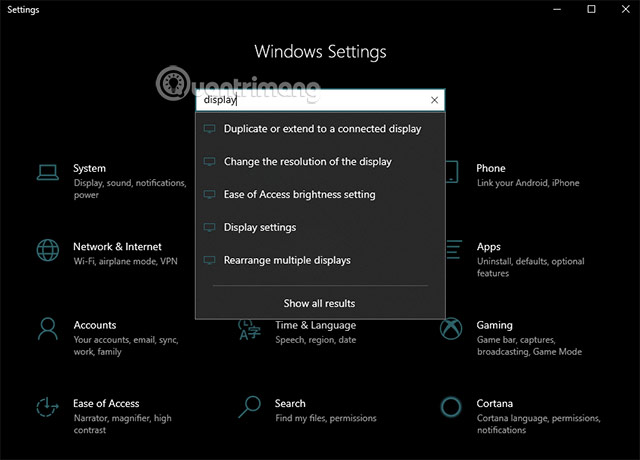 15 ways to adjust the brightness of computer and laptop screens Picture 1
15 ways to adjust the brightness of computer and laptop screens Picture 1
In the Display Settings window, you will see a drag bar in the first section called Brightness and color , you just need to drag this bar to change the brightness of your screen.
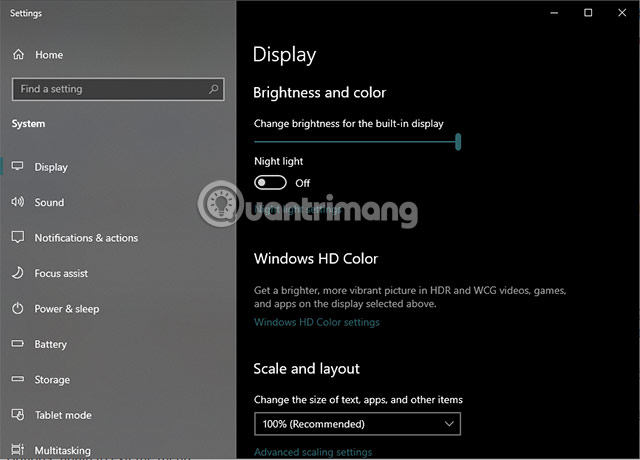 15 ways to adjust the brightness of computer and laptop screens Picture 2
15 ways to adjust the brightness of computer and laptop screens Picture 2
Even changing the screen brightness without using the hard keys on the computer screen. But you still have to go through more steps than reducing the screen brightness on a laptop.
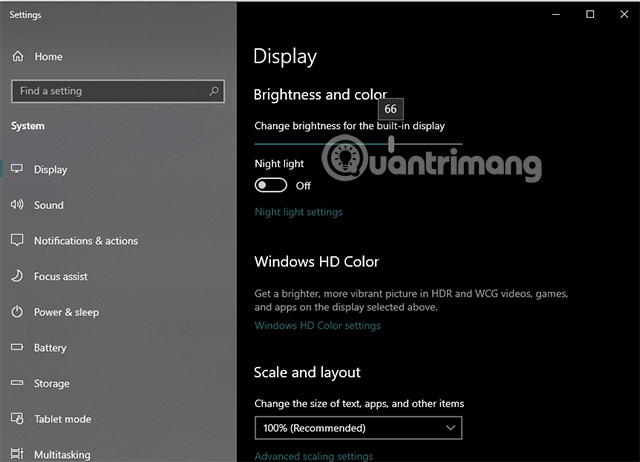 15 ways to adjust the brightness of computer and laptop screens Picture 3
15 ways to adjust the brightness of computer and laptop screens Picture 3
2. Adjust the PC screen brightness using the hardware key
Although the hard keys on the computer screen can be changed, the options will only lead to the Brightness section on the screen. You just need to select the increase or decrease keys to move the selection to the Color > Brightness option to increase or decrease the brightness as you like.
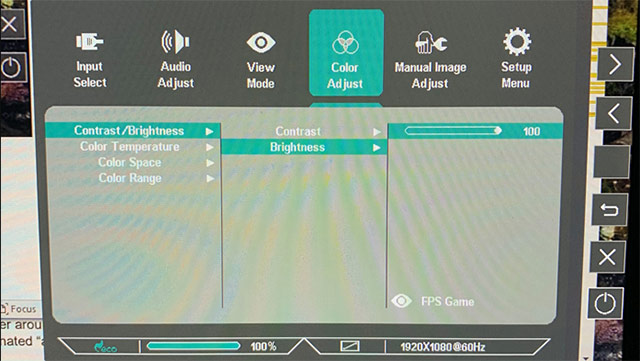 15 ways to adjust the brightness of computer and laptop screens Picture 4
15 ways to adjust the brightness of computer and laptop screens Picture 4
Most Brightness options will be in the Color section and if you look here, a few other screen brands will be in an icon with a .JPG file illustration.
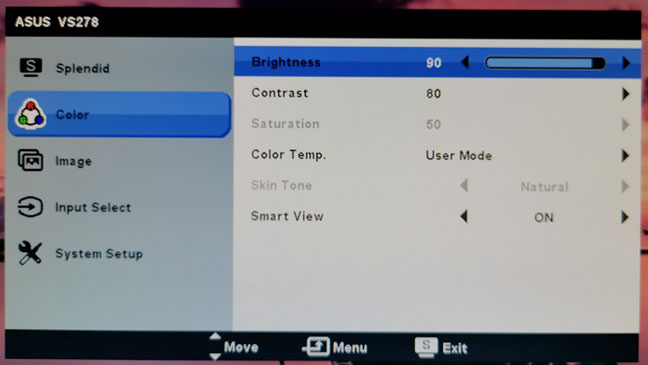 15 ways to adjust the brightness of computer and laptop screens Picture 5
15 ways to adjust the brightness of computer and laptop screens Picture 5
Some high-end monitors will have a dedicated button to adjust brightness (on the front or side of the screen). If your PC screen doesn't have this button, try pressing the buttons and looking in each menu. Refer to your monitor's user manual to find it faster.
3. Reduce brightness using 3rd party software
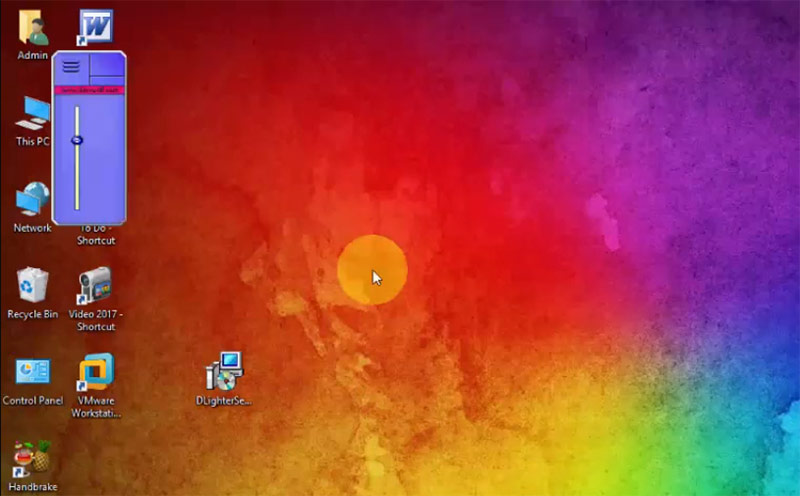 15 ways to adjust the brightness of computer and laptop screens Picture 6
15 ways to adjust the brightness of computer and laptop screens Picture 6
1. f.lux:
f.lux software is free, it helps you adjust the brightness on the screen and even automatically adjusts the screen brightness and color temperature according to the time of day to protect your eyes.
Download at: https://apps.microsoft.com/detail/9n9kdphv91jt?hl=en-US&gl=US
2. Iris:
Similar to f.lux, but Iris will provide more customization for users, including the ability to create schedules to change brightness on the screen. Iris will have two versions, a free version with limited features, the paid version with full features.
3. Gamma Panel:
Gamma Panel allows you to adjust the brightness, contrast and gamma of your screen easily. This software also helps you increase text and image visibility by adjusting brightness and contrast. Adjust gamma to help reduce eye strain when using the computer for long periods of time.
4. ClickMonitorDDC:
ClickMonitorDDC is a free and lightweight software that allows you to adjust various settings on your monitor directly from your computer. Includes screen brightness control through software operation or you can also edit by assigning hotkeys.
You can also adjust the contrast to help images display colors more accurately, along with color temperature correction to help increase the overall color accuracy of the screen, color modes are also available to you choose.
Adjust screen brightness for laptop
1. Adjust screen brightness using the keyboard
Most laptop keyboards have a screen brightness adjustment key to quickly increase and decrease the brightness. Usually, these keys are located with the F key – that is, from F1 to F12 – or in the left and right navigation keys. To adjust the screen brightness, find the corresponding icon – usually a sun symbol or something similar – and press the keys.
These are usually function keys, meaning you must press and hold the Fn key on the keyboard, usually located near the bottom left corner of the keyboard, at the same time as you press them.
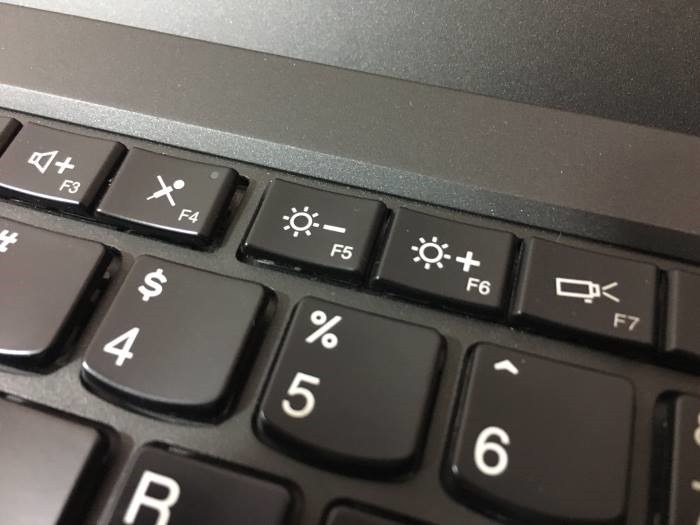 15 ways to adjust the brightness of computer and laptop screens Picture 7
15 ways to adjust the brightness of computer and laptop screens Picture 7
If your laptop doesn't have a separate brightness key, see the ways to adjust screen brightness below.
2. Adjust screen brightness using Action Center
Step 1: Click the Action Center icon in the bottom right corner of the screen to open.
Step 2: On the Action Center control panel, click the brightness tile as shown below to increase or decrease the screen brightness. If you don't see tile brightness, click the Expand button .
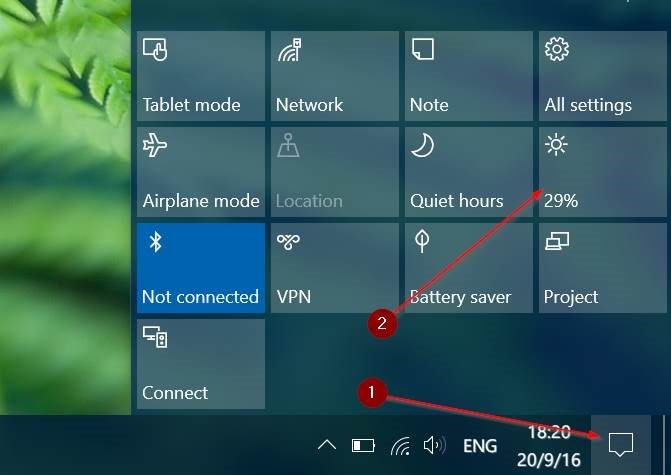 15 ways to adjust the brightness of computer and laptop screens Picture 8
15 ways to adjust the brightness of computer and laptop screens Picture 8
With recent versions of Windows 10 , the screen brightness adjustment bar in Action Center is located right below the features, usually at the bottom. You drag the slider to the left to decrease screen brightness and drag to the right to increase screen brightness.
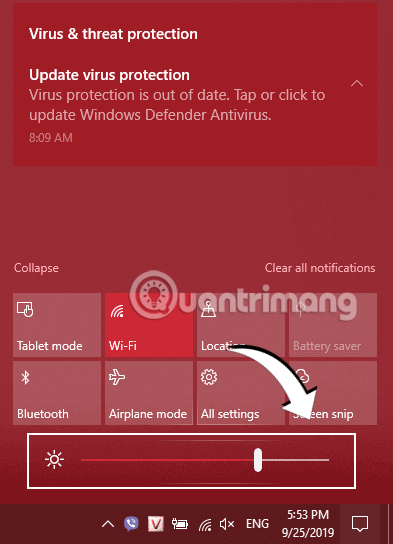 15 ways to adjust the brightness of computer and laptop screens Picture 9
15 ways to adjust the brightness of computer and laptop screens Picture 9
3. Adjust screen brightness from Settings
Press the Windows+ key Ito open Settings and go to System > Display . Below Brightness and color , use the Change brightness slider . Moving to the left will make the screen darker, while moving to the right will make the screen brighter.
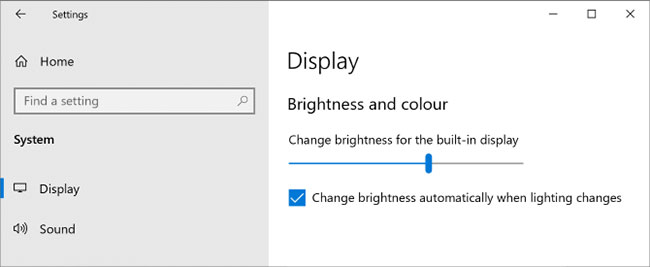 15 ways to adjust the brightness of computer and laptop screens Picture 10
15 ways to adjust the brightness of computer and laptop screens Picture 10
If the slider is not available, there are 2 cases. If you use an external display, use the buttons on it to change the brightness. If not, you need to update the display driver.
To do this, press the Windows+ key Xand click Device Manager . Expand Display adapters and then right-click the graphics card. Click Update driver and follow the wizard.
4. Adjust screen lighting using Control Panel
You may have different brightness levels depending on whether your computer is charging or running low on battery. To save battery, set the brightness level to dimmer when the device is not plugged in.
To do this, press the Windows+ key Rto open Run , type control panel and click OK. Go to Hardware and Sound > Power Options and click Change plan settings next to the settings you selected.
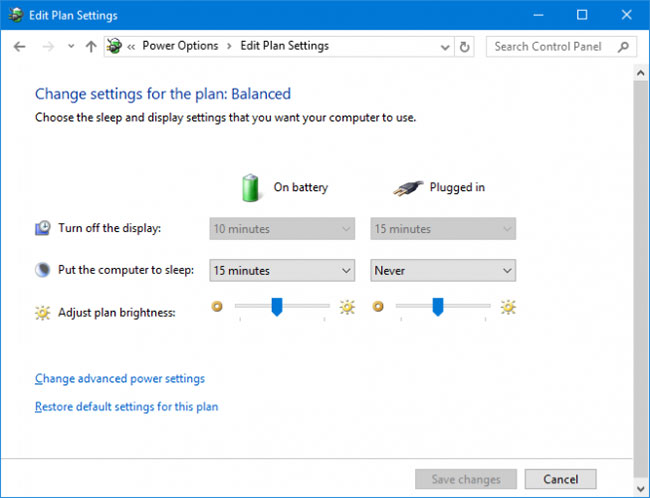 15 ways to adjust the brightness of computer and laptop screens Picture 11
15 ways to adjust the brightness of computer and laptop screens Picture 11
Use the Adjust plan brightness slider to set the On battery and Plugged in levels . Once completed, click Save changes.
5. Adjust screen lighting using Windows Mobility Center
In addition to the ways to change screen brightness mentioned above, you can also change this feature through Windows Mobility Center.
Step 1: Go to the search bar on windows and search for keywords Mobility Center.
Step 2: Click to select and open Windows Mobility Center.
Step 3: Adjust the screen brightness with the slider in the Display brightness section on the window that appears.
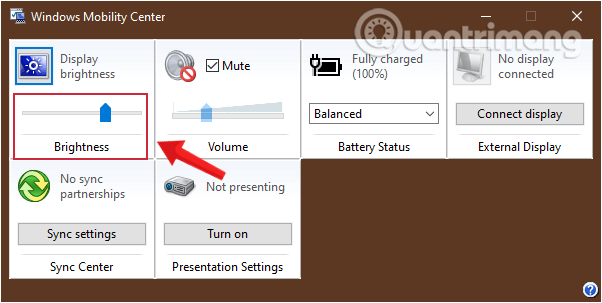 15 ways to adjust the brightness of computer and laptop screens Picture 12
15 ways to adjust the brightness of computer and laptop screens Picture 12
6. Automatic brightness adjustment to increase battery life
Reducing brightness can help increase battery life. Windows 10 has a battery saving feature that automatically reduces brightness when turned on.
To enable this feature, press the Windows+ key Ito open Settings and go to System > Battery , scroll down to Battery saver settings .
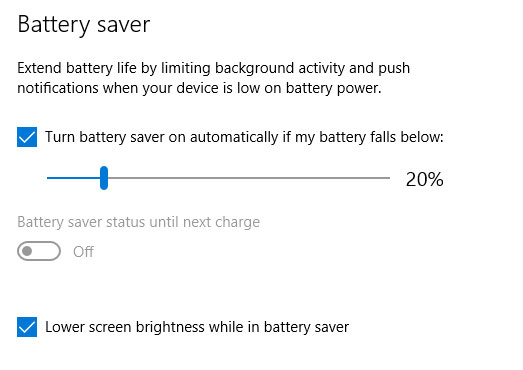 15 ways to adjust the brightness of computer and laptop screens Picture 13
15 ways to adjust the brightness of computer and laptop screens Picture 13
Check Turn battery saver on automatically if my battery falls below and use the slider to adjust the battery percentage level you want the feature to turn on automatically.
Finally, check Lower screen brightness while in battery saver .
7. Adjust brightness using Windows 10 compatibility feature
Ideally, the screen brightness should match the ambient light. One way to ensure this is to have the brightness automatically change based on ambient light.
This feature is only enabled if the device has a brightness sensor. To enable it, press the Windows+ key Ito open Settings and go to System > Display . If you see Change brightness automatically when lighting changes , switch it to On. If you can't see this option, you don't have a sensor.
An even better way to adjust this is through the Control Panel as you can set it depending on your power plan. Refer to section 4 for how to do this.
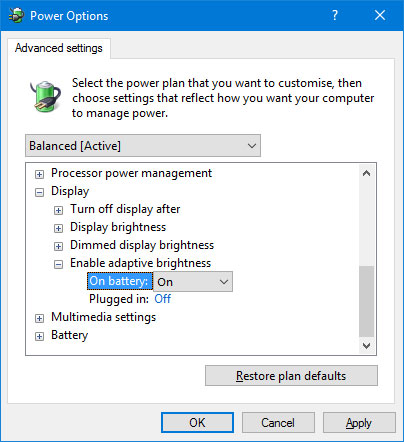 15 ways to adjust the brightness of computer and laptop screens Picture 14
15 ways to adjust the brightness of computer and laptop screens Picture 14
8. Adjust screen brightness with shortcut
Here are two quick shortcuts to adjust brightness settings:
- Shortcut 1 : You can quickly adjust brightness via the Action Center icon on the taskbar (or press the
Windows+ keyA). Use the brightness slider to adjust. The further you move to the right, the brighter the screen becomes.
If you don't see the icon, press Windows+ I, go to System > Notifications & actions > Edit your quick actions and click Add > Brightness > Done .
 15 ways to adjust the brightness of computer and laptop screens Picture 15
15 ways to adjust the brightness of computer and laptop screens Picture 15
- Shortcut 2 : Use a third-party utility called Windows 10 Brightness Slider. This lightweight utility adds a brightness icon in the system tray, which you can then click to adjust the brightness on the slider, the same way the volume icon works.
Go to the project on GitHub, download the file and open it. It will automatically go into the system tray. If you want it to always be there, right-click on the icon and select Run At Startup .
9. How to adjust screen brightness using PowerShell
You can also use the almighty PowerShell to change the screen brightness in Windows 10. Open PowerShell by typing "powershell" in the taskbar search field, then tap Windows PowerShell.
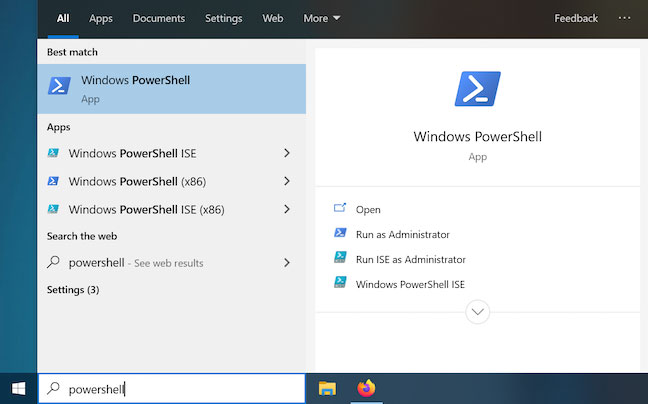 15 ways to adjust the brightness of computer and laptop screens Picture 16
15 ways to adjust the brightness of computer and laptop screens Picture 16
To change brightness, enter the following command:
(Get-WmiObject -Namespace root/WMI -Class WmiMonitorBrightnessMethods).WmiSetBrightness(1,**brightnesslevel)Replace brightnesslevel with the percentage value (%) you want for your screen brightness, from 0 to 100. For example, to set brightness to 70%, enter the following command:
(Get-WmiObject -Namespace root/WMI -Class WmiMonitorBrightnessMethods).WmiSetBrightness(1,70)  15 ways to adjust the brightness of computer and laptop screens Picture 17
15 ways to adjust the brightness of computer and laptop screens Picture 17
As soon as you press Enter , the brightness will be adjusted to your preference.
Adjust screen brightness automatically
1. Adjust brightness when charging automatically
You can set different screen brightness levels on your laptop or tablet based on whether you're plugged in or not. For example, you can set it to a high brightness level when it's plugged in and a lower brightness level when you're on battery. Windows will then automatically adjust your brightness.
To adjust brightness this way, open Control Panel . Select Hardware and Sound > Power Options and click the 'Change plan settings' link next to the power plan you are using. Maybe you are using Balanced power plan .
Configure different screen brightness levels for 'On battery' and 'Plugged in' in 'Adjust plan brightness' . This setting is tied to your power plan. You can configure different screen brightness levels for different power plans and switch between them, if desired (although this isn't strictly necessary).
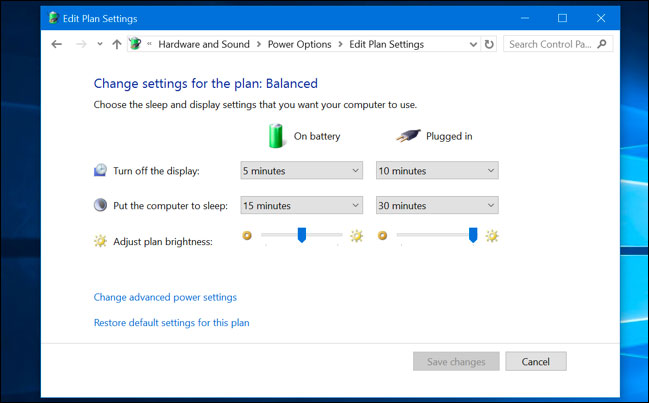 15 ways to adjust the brightness of computer and laptop screens Picture 18
15 ways to adjust the brightness of computer and laptop screens Picture 18
2. Adjust brightness automatically based on remaining battery life
You can also automatically adjust the screen's backlight based on the remaining battery power of your laptop or tablet. On Windows 10, you can use the Battery Saver feature to do this. Open the Settings app , select System > Battery .
Make sure to enable the 'Lower screen brightness while in battery saver' option , then select the percentage you want Battery Saver to use. When Battery Saver activates at that level, the battery saver will reduce the backlight and save energy for you. By default, Battery Saver will work when you have 20% battery left.
Unfortunately, there's no way to adjust the exact brightness level that Battery Saver will choose. You can also enable this feature manually from the battery icon.
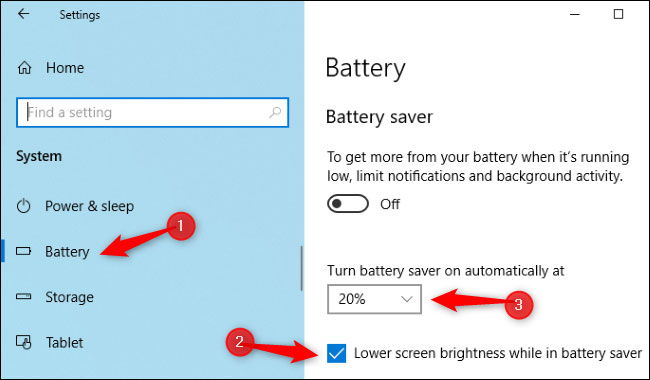 15 ways to adjust the brightness of computer and laptop screens Picture 19
15 ways to adjust the brightness of computer and laptop screens Picture 19
3. How to adjust brightness automatically based on ambient light
Many modern laptops and tablets have ambient brightness sensors, which work similarly to sensors found on smartphones and tablets. Windows can use this sensor to automatically increase screen brightness when you're in a bright area and decrease it when you're in a dark room.
This is convenient, but some people find that it also gets in the way. It can automatically reduce or increase screen brightness when you don't want it to, but you may want to manage brightness manually with the settings above.
To turn this feature on or off on Windows 10, open the Settings app , select System > Display . Turn on or off the 'Change brightness automatically when lighting changes' option . You will only see this option if your device has an ambient brightness sensor.
 15 ways to adjust the brightness of computer and laptop screens Picture 20
15 ways to adjust the brightness of computer and laptop screens Picture 20
You can also change this setting through Control Panel. Open Control Panel , select Hardware and sound > Power Options , click Change plan settings next to the power plan you are using, and click Change advanced power settings .
Expand the Display section here, then expand the Enable adaptive brightness section . The options here let you control whether adaptive brightness is used when on battery or plugged in. For example, you can turn this feature off when plugged in and turn it on when using battery power.
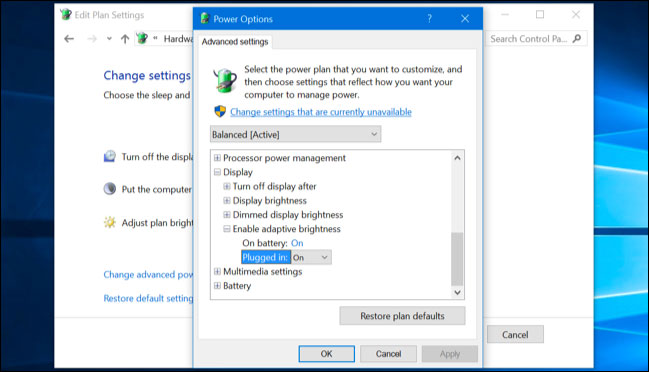 15 ways to adjust the brightness of computer and laptop screens Picture 21
15 ways to adjust the brightness of computer and laptop screens Picture 21
Adjust screen brightness using video card control software
If your device has a video card, you will have another way to adjust the screen brightness. With this method, you use video card control software to adjust your screen to be bright or dark. Depending on the type of video card you use, there will be different software.
With an NVIDIA video card, you will have NVIDIA Control Panel or GeForce Experience software. Meanwhile, with an AMD video card you will have AMD Radeon Software or Catalyst Control Center.
Each software will have a different interface, but you just need to find the Brightness adjustment section and make changes to your liking.
Adjust your computer screen brightness using third-party software
Besides the methods available on your device, you can also use third-party software to adjust the brightness of your computer screen. Screen brightness adjustment software is often designed so you can easily adjust, create shortcuts.
You can refer to one of the following software:
- Twinkle Tray Brightness Slider (easy to use, multi-screen adjustable)
Twinkle Tray allows you to easily manage the brightness levels of multiple displays. While Windows 10 & 11 have the ability to adjust the backlight on most displays, it generally does not support external displays. Windows also lacks the ability to manage the brightness of multiple displays.
This app adds a new icon to the system tray, where you can click to instantly access the brightness levels of all compatible displays. These brightness sliders can adjust one or all displays at once.
Twinkle Tray will automatically adjust its appearance to match your Windows version and color preferences. Additional options are available to select the style and theme of the Windows version you choose.
Twinkle Tray offers many options and features to suit your preferences. All are 100% free. Outstanding features of this tool include:
- Seamless integration with Windows 10 & Windows 11.
- Works with most laptops and monitors that support DDC/CI.
- Bind hotkeys to adjust the brightness of a specific screen or all screens.
- Control DDC/CI features such as contrast, volume, and power status.
- Supports adjusting brightness according to time of day or idle time.
- Supports command line arguments for custom scripts.
- Normalize backlight on different screens.
- Localized for more than 20 languages.
- Start with Windows.
Twinkle Tray uses DDC/CI and WMI to communicate with your display. Make sure you have the appropriate option(s) enabled on your display so it can work with Twinkle Tray. Twinkle Tray is available for download from the Microsoft Store or as an installer from GitHub (recommended).
- Desktop Lighter
Desktop Lighter is a software package that allows users to easily adjust the brightness of their computer screen. This tool can be advantageous in low-light situations or when a screen that is too bright may disturb others. It's also a great idea when reading large blocks of text, as the eyes can get tired. This program is completely free to download.
One of the main benefits of Desktop Lighter is that there is no need to visit the Control Panel to manually adjust the screen brightness. An icon will be found in the toolbar at the bottom of the page. Clicking on this image opens a window showing the slider. Users will only need to move this bar left or right to adjust the brightness of the screen.
Desktop Lighter offers two additional options. This program can be pre-set to work with a hotkey. Another possibility is to enlarge the entire window for easier reading. Many people assume that this was created for the visually impaired. This package is freeware, so there is no charge to download and install it.
- F.lux (capable of automatically adjusting screen brightness via time zone, time and detecting environmental light)
Most of these software are very easy to use, you just need to download, extract (if it is a compressed file), then run the installation file (usually .exe). Once installed, you can immediately adjust the brightness of your computer screen.
Error adjusting Windows 10 screen brightness
Brightness problems on your computer are often related to display drivers and other power settings that you may or may not be aware of.
If Windows doesn't let you adjust the brightness on your PC or laptop, these are the first two areas to check besides trying the usual common fixes like restarting your computer or updating Windows.
While updating Windows will help install the latest drivers that may be pending, there are other solutions you can try to see if that helps you regain control of the brightness on your display. me or not.
Refer to the article: Fix error of not being able to adjust screen brightness on Windows 10 for more details.
Be sure to adjust the brightness of your computer screen
Why is my laptop screen so dark?
Anything from a faulty display driver to a problematic display can be the reason behind a dim, dark screen. However, the most common reason is incorrect screen brightness settings in Windows 10. But before you start increasing screen brightness, observe the surrounding light and any sources of glare ( Sunlight is the main source of ambient light during the day).
Try changing your position to test the impact of ambient light on your screen. Additionally, anti-infrared/anti-UV films may reduce brightness by imparting color.
Is low computer brightness better for your eyes?
As a simple rule of thumb, remember that the brightness of your device should be comparable to the light around you, so that the shine of both light sources is similar. By doing so, they will blend together and cause the least harm to your eyes.
In particular, when using a monitor for work, you will often compare paper documents with documents on the screen, so by adjusting the brightness of the screen to the brightness of the paper under the light, you will reduces eye strain, making this an effective remedy against eye strain.
What is the best brightness for a computer?
For most situations - like normal office conditions - setting the brightness to 60 is about right. However, you can adjust the brightness lower if it's getting darker outside, or increase the brightness if it's too bright outside - for example, if you're working outside in the summer or in a real room. bright enough.
On a laptop, what percentage of brightness is best for the eyes?
Most people are comfortable with contrast set between 60 and 70%. Once you have the contrast at the right point, you can move on to the brightness settings. The goal here is to have the light from your screen emit similarly to the light in your workspace.
How to increase screen brightness on Mac laptop?
To adjust your MacBook display brightness, go to the Apple menu and choose System Preferences > Displays , then click Display , then use the brightness slider to adjust the brightness of your display.
How to reduce screen brightness even lower on laptop?
To lower the brightness setting below the lowest level on your laptop, you will need a third-party application, such as Dimmer, PangoBright or CareUEyes. These programs are useful if even the lowest brightness setting causes discomfort to your eyes.
How to fix the error of the screen being too dark even though the brightness setting is high?
If your screen is too dark, even at maximum brightness, there are some troubleshooting steps to try. Try uninstalling and reinstalling the display driver: Go to Device Manager , select Display driver , right-click your driver name (e.g. Nvidia), select Uninstall and follow the prompts. Restart the computer to reinstall the driver. Another option is to update the BIOS on the system.
You should read it
- Instructions to adjust the screen brightness of Android phones
- Adjust screen brightness of Windows 7 on PC, laptop
- How to adjust the screen brightness of Windows 10 on the desktop
- Manual manual and automatic computer screen brightness adjustment
- Tutorial 4 ways to adjust the screen brightness of Windows 10
- How to adjust screen brightness from Terminal in macOS
- How to adjust the brightness of the Laptop computer screen
- What is Nit when it comes to screen brightness?
- Top software to adjust the best computer screen brightness
- How to adjust the screen brightness on Windows 10 Laptop
- Error not adjusting screen brightness after upgrading Windows 8.1
- What is Nit screen brightness?
May be interested

Users will have to pay for Windows 10 security updates

How to change WinX menu on Windows 10

How to show My Computer in Windows 10

How to change computer name on Windows 10, 11 is extremely easy

What is Windows 10 Education? Learn about Windows 10 and 11 versions for education

How to enable and use Hyper-V on Windows 10






 What is Nit when it comes to screen brightness?
What is Nit when it comes to screen brightness? How to adjust the brightness of the Laptop computer screen
How to adjust the brightness of the Laptop computer screen How to adjust the screen brightness on Windows 10 Laptop
How to adjust the screen brightness on Windows 10 Laptop 9+ ways to adjust computer screen brightness in Windows 8, 10
9+ ways to adjust computer screen brightness in Windows 8, 10 Adjust screen brightness of Windows 7 on PC, laptop
Adjust screen brightness of Windows 7 on PC, laptop Tutorial 4 ways to adjust the screen brightness of Windows 10
Tutorial 4 ways to adjust the screen brightness of Windows 10